How to Write a Successful Project Proposal
Learn how to create a compelling pitch for your next project and get it approved by the stakeholders.
Being able to successfully present your ideas is a vital skill for getting your projects approved.
Giving a convincing elevator pitch is often not enough – you need to create a formal, structured document that explains why your ideas are worth being executed and addresses the stakeholders' concerns before they had a chance to voice them.
Let's dive deeper into what a project proposal is and how to write it.
- What is a project proposal?
- Project proposal example
- How to write a project proposal
- Project proposal template
- Tips for creating a persuasive project proposal
What is a project proposal?
A project proposal is a document that outlines your project’s core value proposition and sells it to the stakeholder. Simply put, it establishes what the project is, what you are aiming to achieve with it, how you plan to get there, and why it's a worthwhile endeavor. Writing it is the first step in the project management process.
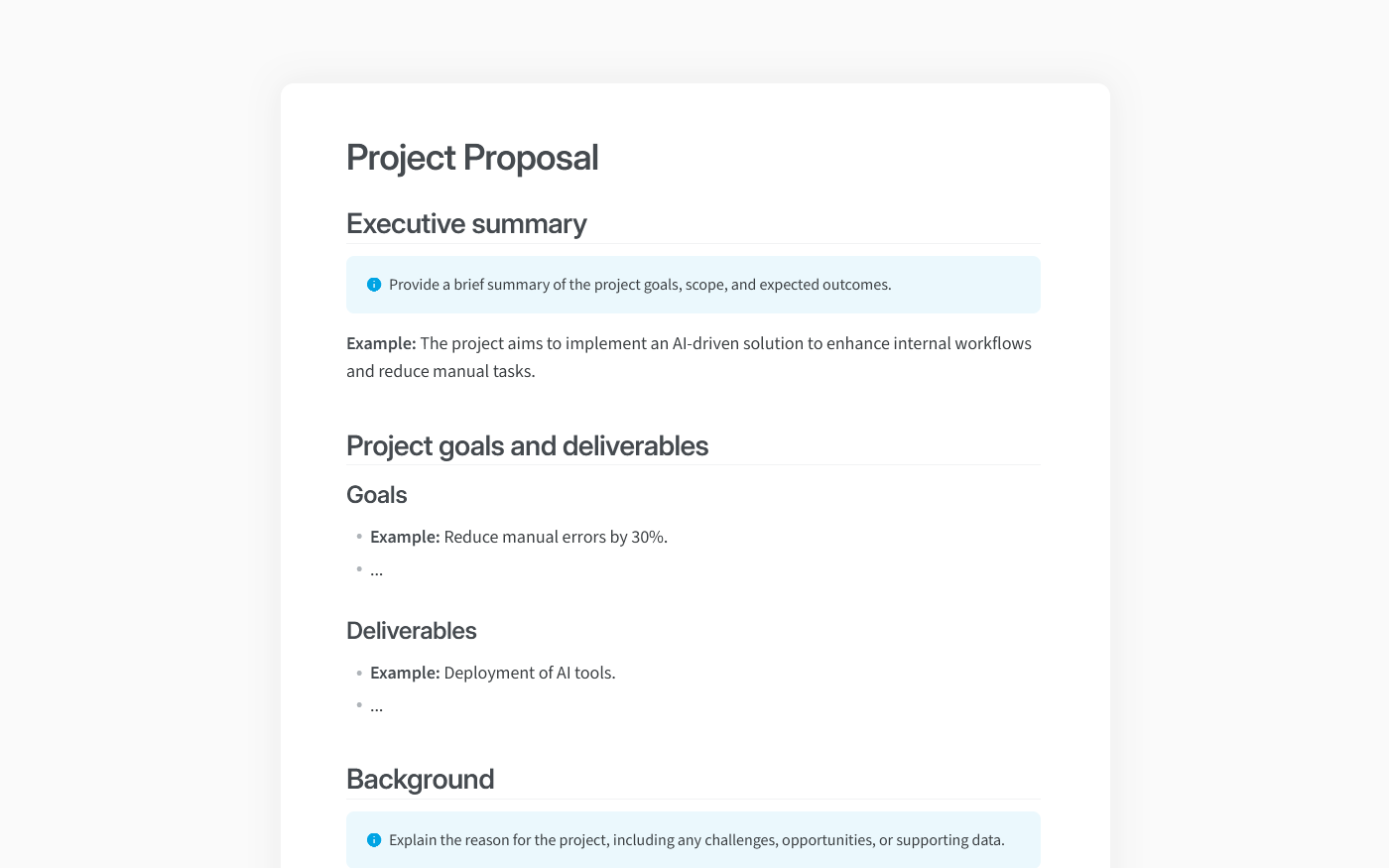
A project proposal may include a list of activities or tasks that will be associated with the project, but it doesn't go into the same level of detail as a project plan.
There are many reasons why you might what to create a formal proposal for your project – to win a new client, to secure funding, to convince your manager to allocate resources to your initiative, and many more. In any case, a well-written, clear, and detailed document is usually the best way to approach it:
A project proposal helps you get a buy-in at your organization.
It creates clarity about the goals, priorities, and requirements of the project.
It forces the project initiator to think through the project details before pitching it.
After the project proposal is approved by all the stakeholders, it becomes the foundation of the project plan.
Project proposal example
No two project proposals are alike, and depending on the nature of your project you may want to follow a different format. There are various types of project proposals:
Internal or external (intended to get buy-in from internal or external stakeholders)
Solicited or unsolicited (created in response to an official request for proposal or written ad-hoc)
Continuation (an update to an ongoing and already approved project)
Renewal (put forward to restart a terminated project)
Supplemental (used to request additional resources for an existing project)
The amount of detail in your project proposal can also vary significantly. In some cases, a simple and brief one-pager proposal would suffice, while in others, you would need to cover every point in great detail, creating an extensive document spanning many pages.
Here's what a project proposal example can look like in Nuclino:
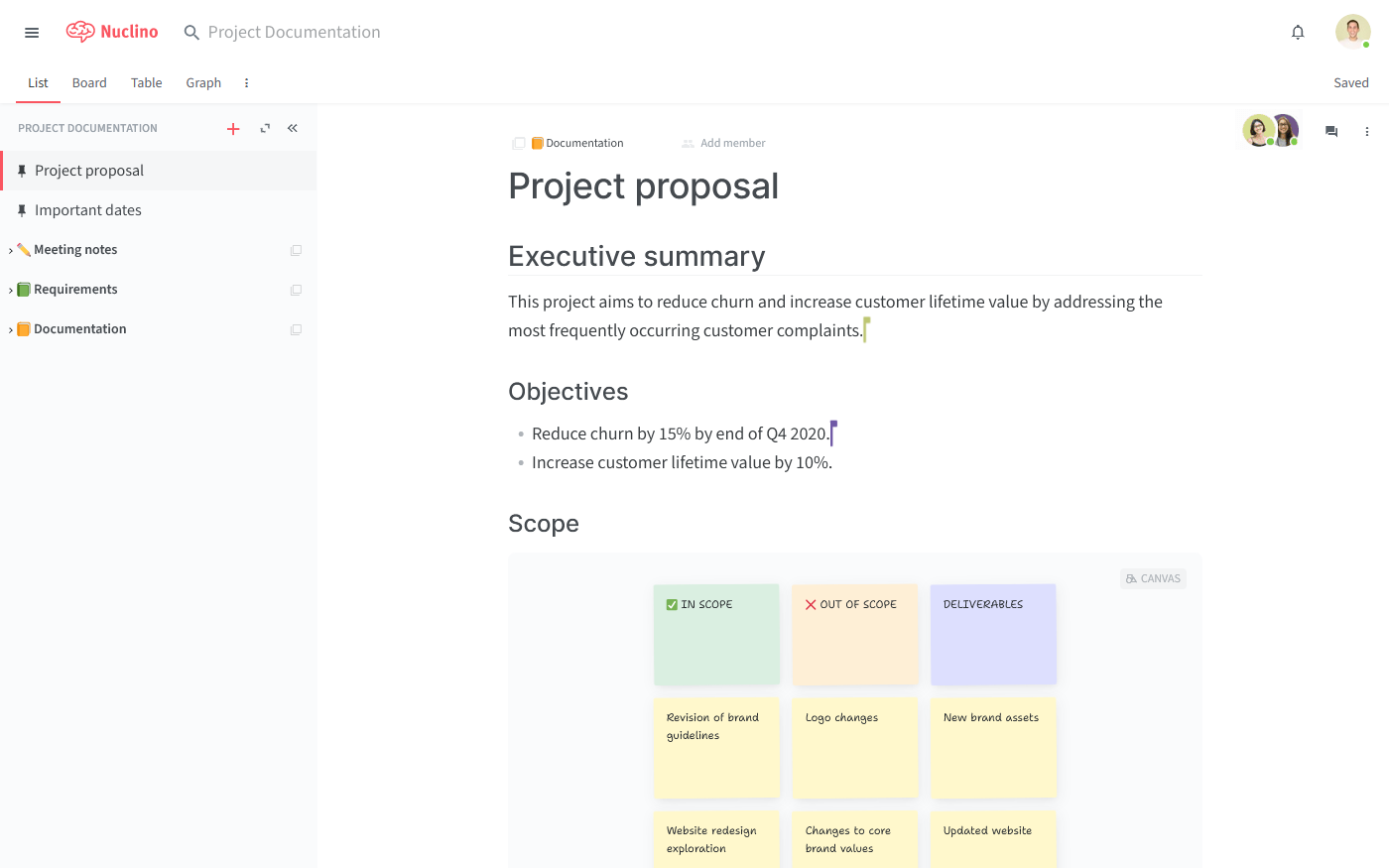
Nuclino is a unified workspace where you can not only manage your projects and collaborate on project documentation, but also build your internal knowledge base, onboard new employees, take meeting minutes, and more. It works like a collective brain, allowing you to bring all your team's work together in one place and collaborate without the chaos of files and folders, context switching, or silos.
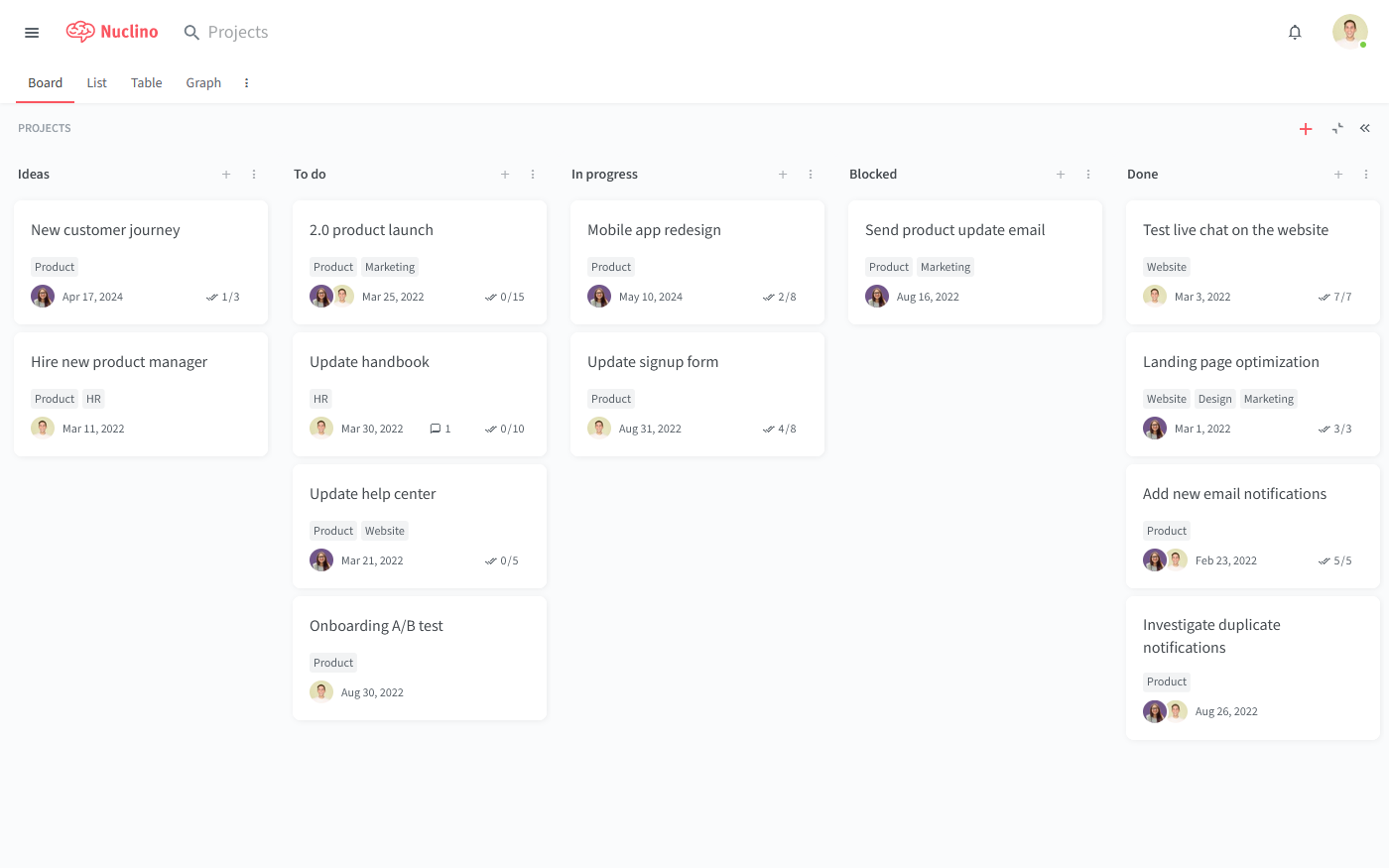
Nuclino also offers built-in visual collaboration and allows you to add an infinite collaborative canvas to any project document. You can use it to create flowcharts and diagrams, brainstorm ideas using sticky notes, build moodboards, and much more.
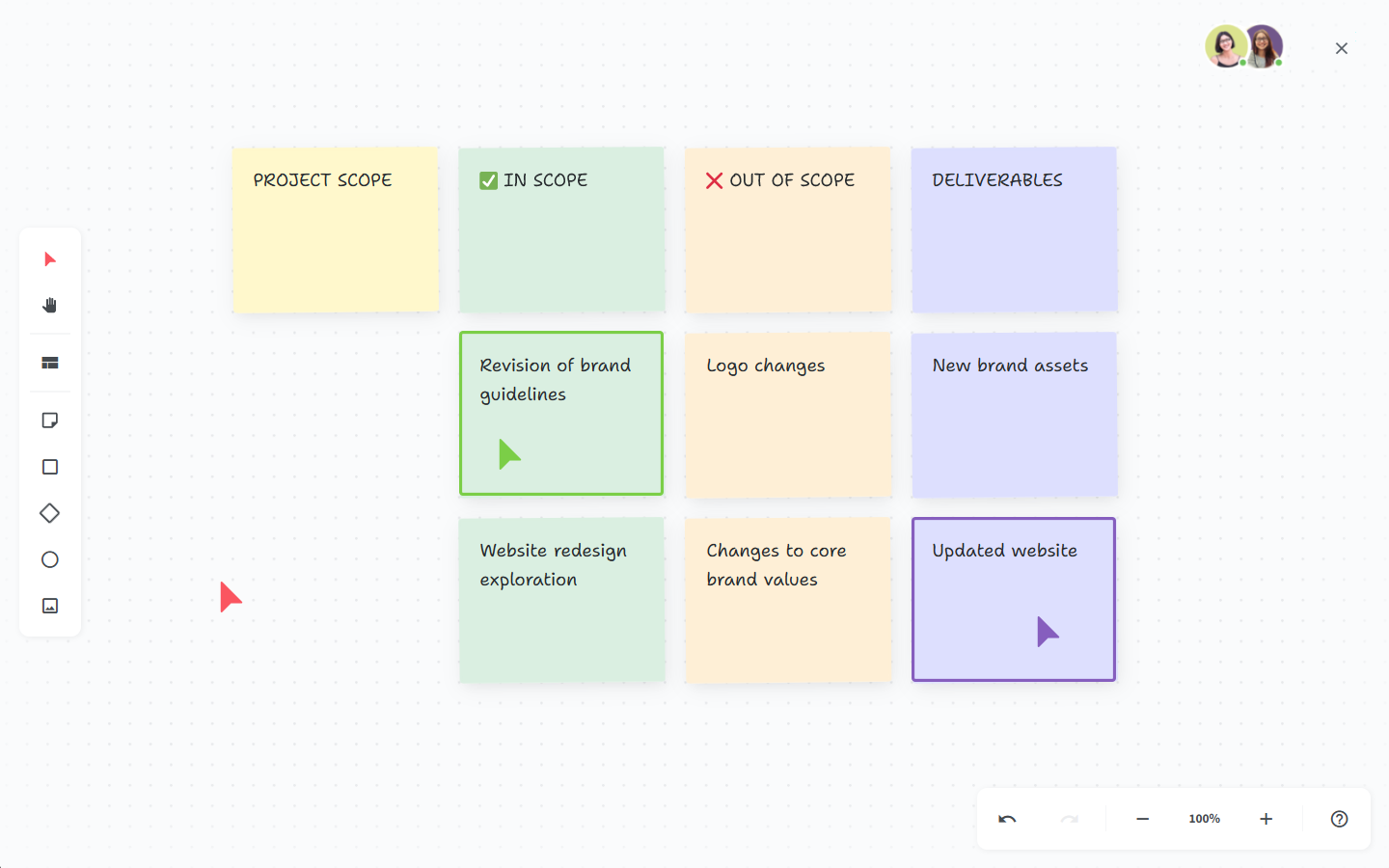
How to write a project proposal
Include an executive summary
The executive summary is the first and most important part of your project proposal and should be written last. If it fails to capture the attention of your readers and make a compelling point, it may doom your proposal right then and there. Think of it as the elevator pitch for your project and focus on describing what success would look like.
Here are some guiding questions to help you get started:
What problem does your project aim to solve?
Why is it important to solve it?
How will it help solve it?
Remember, the goal is to create a compelling snapshot of your project. If you're struggling to condense your ideas, a text summarizer tool can offer a fresh perspective, helping you identify the most crucial elements to include while keeping your summary concise and impactful.
Include the project background
Include a section where you go into more detail about the problem you are solving. Prove to your readers why they should care about this project and back your claims with relevant references and statistics.
Consider providing answers to the following questions:
What is the history of the problem? How long has it existed?
How is solving it related to the business goals of your organization?
Explain your solution
After you have described the problem, it's time to lay out the proposed solution:
How will you solve the problem you described?
Why will the proposed solution be effective?
Why is the proposed solution better than alternatives?
What would it take to make it happen?
Define the deliverables and success criteria
Make it clear how the success of your proposed project will be measured:
What will be the project deliverables?
What are the SMART (specific, measurable, achievable, realistic, and time-bound) objectives of the project?
List the required resources
Be realistic and detailed when you estimate your project budget requirements. Include the supplies, tools, ad spend including cost per click, salaries, and whatever else would be required to successfully deliver the project.
A detailed financial breakdown will signal to the stakeholders that you've done your research and assure them that there wouldn't be many unexpected costs down the road. If you're working on a project for an external client, a good way to avoid any surprises would be to provide them with a formal cost estimate and get their approval.
You may want to conclude the document with a brief conclusion. Reiterate the points you made and remind your audience why they should approve your proposal, without introducing any new information.
Project proposal template
As previously mentioned, there is no one-size-fits-all format. But this simple project proposal template can be a great starting point:

Tips for creating a persuasive project proposal
Using a good template does not guarantee the success of your project proposals. Following a clear structure is important, but that alone is not enough.
There are several noteworthy best practices that can help you make your proposal as compelling as possible.
Understand your audience and write for it
No matter how great and innovative your initiative is, it will fail to persuade your readers if you don't convey it in a way they would understand.
Try to answer the following questions as you write:
What is the background of your readers – specifically, the decision-makers? Would they understand specialized terminology or would it be better to use simpler language?
What would they find more convincing? Data? Visuals? User feedback?
What tone of voice is likely to resonate with them? Formal or informal?
Keep it brief and simple
There is probably a lot you can say about your project – you have likely been thinking about it a lot. But is all that information relevant to the point you are trying to make? Focus on what would strengthen your pitch and provide as much detail as needed, not as much as possible.
Make your solution SMART
Avoid vague goals such as "increase MRR" or "optimize a process". Make sure your proposal clearly defines the success criteria of your project and keeps it SMART (specific, measurable, achievable, realistic, and time-bound).
Anticipate questions and objections
Be prepared to defend your solution. Don't wait for the stakeholders to voice their objections – address them directly in your project proposal.
Writing formal project proposals may seem like a hassle, especially when you are confident in your idea. But not all great ideas get approved or funded – in many cases, whether your initiative sees the light of day depends on how effective and convincing your proposal is.
Nuclino: Your team's collective brain
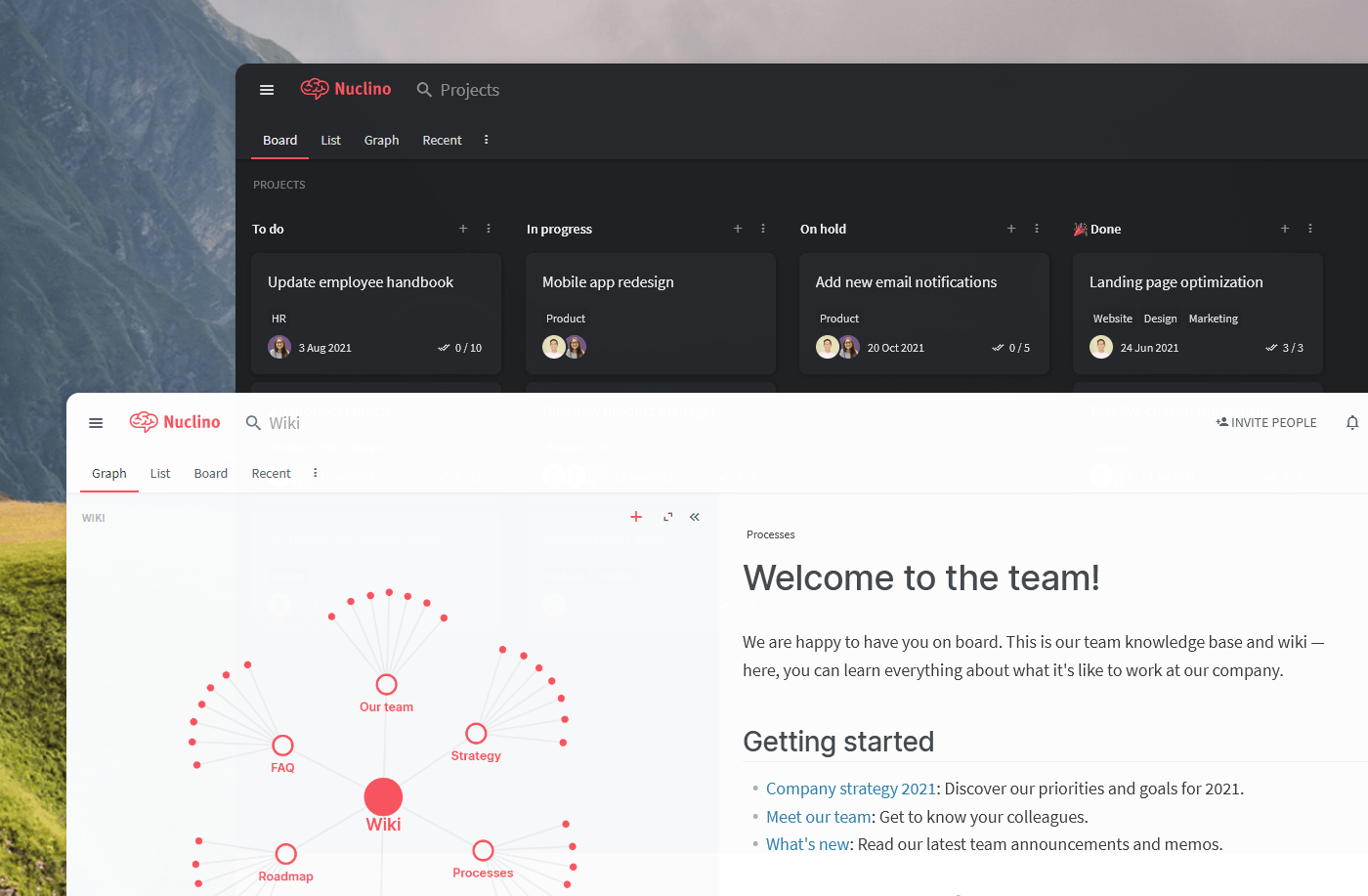
Nuclino brings all your team's knowledge, docs, and projects together in one place. It's a modern, simple, and blazingly fast way to collaborate, without the chaos of files and folders, context switching, or silos.
Create a central knowledge base and give your team a single source of truth.
Collaborate in real time or asynchronously and spend less time in meetings.
Manage and document your projects in one place without losing context.
Organize, sort, and filter all kinds of data with ease.
Integrate the tools you love, like Slack, Google Drive, Figma, Lucidchart, and more.
Ready to get started?
